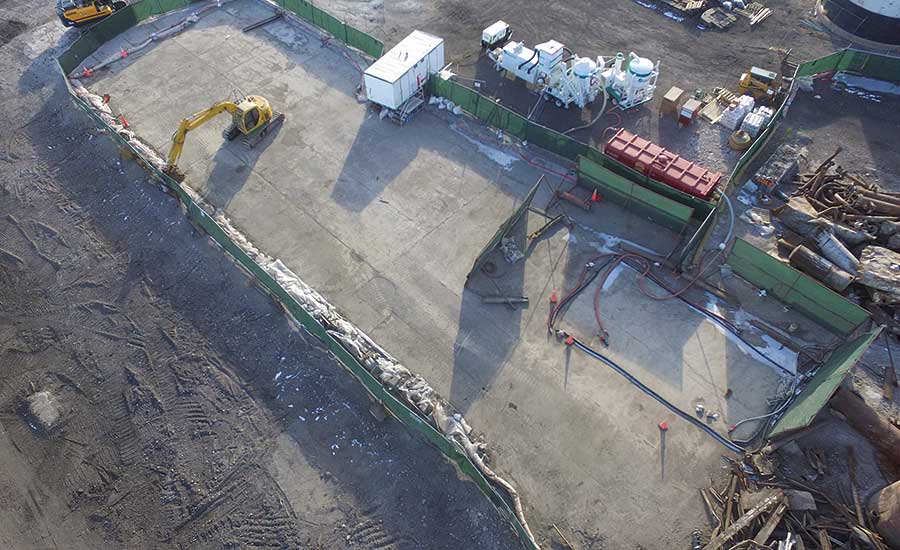The small town of Ovid rests in the far northeast corner of Colorado near the Nebraska border. The town retains a significant historical landmark: the gleaming white storage silos containing beet sugar from what once was the Great Western Sugar Company’s finest factory.
Colorado’s once booming sugar economy died off with the expiration of the Sugar Act in 1974. Ovid’s GW factory was closed in 1976, and by September of 2006 the entire domestic beet sugar industry had become grower-owned. Amalgamated Sugar, a cooperative of sugar beet farmers, bought the Ovid property in 2002, not anticipating the liability they were taking on.
The abandoned factory was truly dangerous—structurally unsound and riddled with asbestos. In 2011, a death at an abandoned sugar factory in Eaton, Colorado brought attention to the need to demolish and abate these sites when a 23-year-old man died after plunging 75 feet from its roof while exploring the ruins.
Eliminating liability
Amalgamated Sugar made the commitment to abate and demolish the factory site, which included 11 smaller buildings, the 116,000 square foot Mill Building, and a 146-acre site.
The enormous price tag for the job would have to be borne by the cooperative’s 750 farmers themselves, with no hope for return on their money. The co-op deemed the investment worthwhile—for no other purpose than to eliminate their looming liability. They contracted with an environmental consultant to devise a plan for abatement and demolition that would leave only the sugar storage silos and one warehouse standing.
Five years in planning stages
Over a period of five years, the environmental consultant conducted extensive research and worked a complex series of proposals with the Colorado Department of Public Health and Environment (CDPHE). Several abatement and demolition firms bid on the project, intending to use traditional methods, fully containing the structure in poly sheeting and then demolishing the structures after all asbestos had been removed. The costs were astronomical, ranging from $7.3 to $11 million.
Another abatement and demolition firm in Commerce City, Colo. proposed an alternate plan that might, if successful, save Amalgamated millions of dollars.
Central to the problem was the Mill Building. According to the environmental consultant, the Mill Building was like a massive city within itself. It housed its own power plant, huge boilers, and rusted machinery. The upper floors were collapsing. Engineers and the local fire department assessed the building, and calculated what would be necessary to rebuild parts of the structure to make it sound enough to proceed with the asbestos abatement.
Unsafe to abate
The customary method for abating the Mill Building would have been first to enclose it, abate the asbestos, and then to demolish the building. However, there were tremendous safety concerns related to abating the main mill structure. Walls were collapsing, floors had dangerous penetrations, and handrails were mangled and broken. In short: it was unsafe to abate. The Commerce City abatement/demo contractor thought there must be a safer way that would also be more cost-effective. The firm teamed up with the environmental consultant and CDPHE to devise a safer process that would cut costs by several million dollars.
The abatement/demo contractor had two main challenges: get the local landfill to approve a one-time asbestos permit to accept the waste so that trucks would not have to haul the material three hours each way, and convince the Colorado Department of Public Health and Environment (CDPHE) to approve a variance allowing for demolition of the mill with the asbestos still inside. Working collaboratively with CDPHE, they were able to do both.
Nontraditional asbestos removal
The strategy included traditional abatement and demolition of the smaller structures first since they were safe to abate. Once complete, they proposed traditional abatement on any easy-to-access sections of the main mill, removing as much bulk asbestos as safely feasible. Complete structural demolition of the mill would follow, leaving the remaining asbestos in place. Once demolished, all trucks would be lined and wrapped so that the materials could be hauled without emissions. If successful, this would avoid the tremendous hazards of abatement in a structurally unsound building, as well as millions of dollars in labor and plastic used for traditional abatement.
Unique about the abatement/demo contracting firm, according to the consultant, was that their project manager previously worked within regulatory agencies and as a consultant. He knew both sides of the equation. His extensive experience working with the CDPHE made him instrumental to obtaining the variance we needed.
Washing & recycling
In August 2016, the unusual plan was approved. The team was to provide at least one dedicated certified asbestos abatement supervisor on site at all times during structurally unsound demolition and debris removal activities. Full-time inspection and air monitoring personnel were also required at all times.
CDPHE also issued a variance allowing the abatement/demo contractor to wash and recycle tons of steel beams and other metal from the wreckage. Metal was cleaned inside a dedicated cleaning area and the AMS/BI (Air Monitoring Specialist/Building Inspector) visually inspected the metal for any dust and debris prior to the metal being moved outside the work area. The clean metal could then be moved from the work area to the clean recycling area to be loaded on rail cars or trucks for recycling.
What’s next for the remaining 21 abandoned sugar factories in Colorado? After this groundbreaking work in Ovid, perhaps more abandoned factories will follow suit. Co-owner Kristian Mitchell summed it up: "Our focus on this project was to show that safety must come first on projects of this nature. Sometimes a common sense approach in working with the state can yield results that are not only safer for the public health and the environment, but also more affordable for clients."






